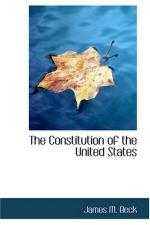Anticipating the masterly ability with which a seemingly impotent and dying nation plucked from the nettle of danger the flower of safety, let me conclude this first address by quoting the words of de Tocqueville, in his remarkable work Democracy in America, where he says:
“The Federal Government, condemned to impotence by its Constitution and no longer sustained by the presence of common danger ... was already on the verge of destruction when it officially proclaimed its inability to conduct the government and appealed to the constituent authority of the nation.... It is a novelty in the history of a society to see a calm and scrutinizing eye turned upon itself, when apprised by the legislature that the wheels of government are stopped; to see it carefully examine the extent of the field and patiently wait for two years until a remedy was discovered, which it voluntarily adopted, without having ever wrung a tear or a drop of blood from mankind.”
II. The Great Convention
Now follows a notable and yet little known scene in the drama of history. It reveals a people who, without shedding a drop of blood, calmly and deliberately abolished one government, substituted another, and erected it upon foundations which have hitherto proved enduring. Even the superstructure slowly erected upon these foundations has suffered little change in the most changing period of the world’s history, and until recently its additions, few in number, have varied little from the plans of the original architects. The Constitution is to-day, not a ruined Parthenon, but rather as one of those Gothic masterpieces, against which the storms of passionate strife have beaten in vain. The foundations were laid at a time when disorder was rampant and anarchy widely prevalent. As I have already shown in my first lecture, credit was gone, business paralysed, lawlessness triumphant, and not only between class and class, but between State and State, there were acute controversies and an alarming disunity of spirit. To weld thirteen jealous and discordant States, demoralized by an exhausting war, into a unified and efficient nation against their wills, was a seemingly impossible task. Frederick the so-called Great had said that a federal union of widely scattered communities was impossible. Its final accomplishment has blinded the world to the essential difficulty of the problem.
The time was May 25, 1787; the place, the State House in Philadelphia, a little town of not more than 20,000 people, and, at that time, as remote, measured by the facilities of communication, to the centres of civilization as is now Vladivostok.
The dramatis personae in this drama, though few in numbers, were, however, worthy of the task.
Seventy-two had originally been offered or given credentials, for each State was permitted to send as many delegates as it pleased, inasmuch as the States were to vote in the convention as units. Of these, the greatest actual attendance was fifty-five, and at the end of the convention a saving remnant of only thirty-nine remained to finish a work which was to immortalize its participants.




